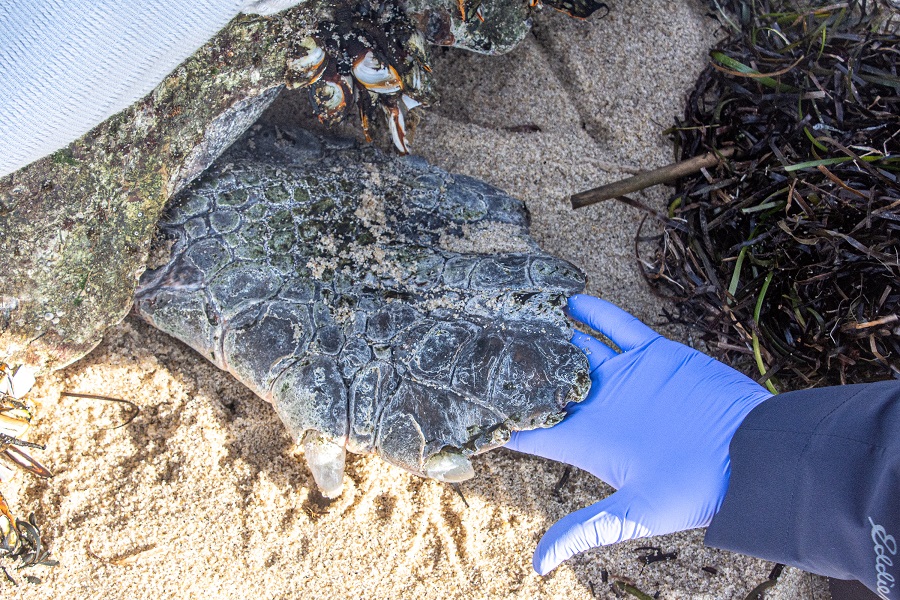The Big Cc, a 350-pound loggerhead sea turtle who washed ashore — upside-down and cold-stunned — near Truro’s Great Hollow Beach on Nov. 20, died four days later in the New England Aquarium’s turtle ward. He was between 30 and 100 years old, barnacled, and he smelled, said Kyle Halvorsen, one of his Truro Dept. of Public Works rescuers, like oysters.
Upon his arrival, New England Aquarium veterinarians named The Big Cc after his considerable bulk and his genus and species, Caretta caretta. He didn’t look good — but that was not a surprise to his caretakers.
“Sea turtles, generally, are spectacular,” said David Godfrey, executive director of the Florida-based Sea Turtle Conservancy. Hawksbill shells gleam; green turtle shells dazzle. Leatherbacks stun; tiny Kemp’s ridleys charm. Loggerheads?
“What’s a polite way to say this?” Godfrey asked. “Loggerheads are, well, rougher looking.”

The Big Cc, said Godfrey, should have been on his way to tropical nesting beaches by now. But like so many seasonal residents this unusual year, he overstayed his Cape Cod welcome. And this turtle paid the price.
A beach-walker reported his stranding, which was in itself unusual. Though cold-stunning season has officially begun, it usually affects small juvenile turtles more than large adults.
Truro DPW staff responded to his stranding (reported in more detail in last week’s Independent) after the Mass Audubon Turtle Team realized their standard turtle cart was no match for the specimen.
“It was the biggest turtle I’d ever seen,” said Mike Locke of the DPW. “Huge.”
“I’ve got size 12 feet,” said Halvorsen. “I took a picture of my foot next to its head and it looked” — he squeezed together his thumb and forefinger — “like that.”
It took the combined efforts of Locke, Halvorsen, Jeff Holway, Tim King, Peter Morris, and firefighters James Willis and Demi Miskiv to load The Big Cc into Locke’s truck bed. Then he made his way to the Wellfleet Bay Sanctuary, where Sea Turtle Stranding Coordinator Karen Dourdeville organized his transportation to the New England Aquarium.
“He was magnificent,” she said. “Massive and magnificent. And in urgent need of care.”
The Big Cc arrived at the New England Aquarium minimally responsive and hardly breathing, said Connie Merigo, director of the Aquarium’s rescue and rehabilitation dept. When a team of veterinarians intubated The Big Cc (yes, you can intubate a turtle — and put one on a ventilator, too) water streamed out of his lungs; the medical team began treating him immediately for pneumonia and medicating him for other derangements in his blood.
The Big Cc responded well to his first night of treatment, which he spent in a pool of shallow water — sea turtle bliss — in the turtle ward. His condition, though, worsened quickly. After three days of constant care, he took his final breaths.
An Aquarium necropsy revealed that, husky though he seemed, The Big Cc weighed 50 to 100 pounds less than he should have. He was dehydrated, emaciated. A portion of his shell was missing. “There was something chronic going on,” said Merigo.
Even for perfectly healthy loggerheads — and other turtles that inhabit the ocean — today’s waters present a sea of dangers. Boats hit them; they get tangled in debris; they ingest plastic. And, of course, the yearly cycle of cold-stunning poses a threat to populations.
When it comes to cold-stunning, if you encounter a stranded turtle of any size and any smell, call the Audubon Sanctuary at 508-349-2615.



